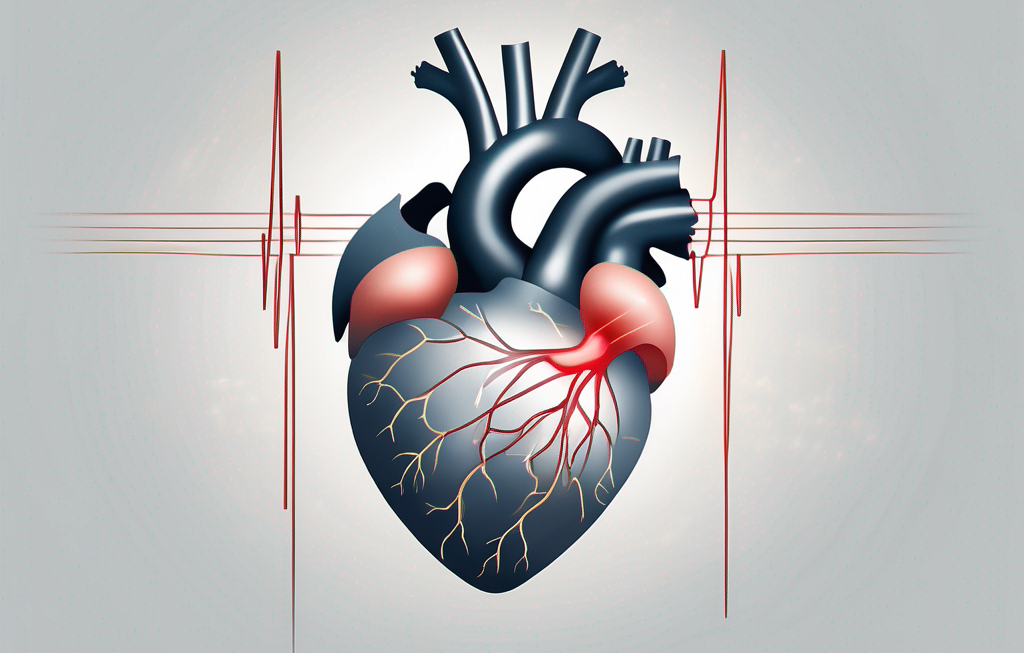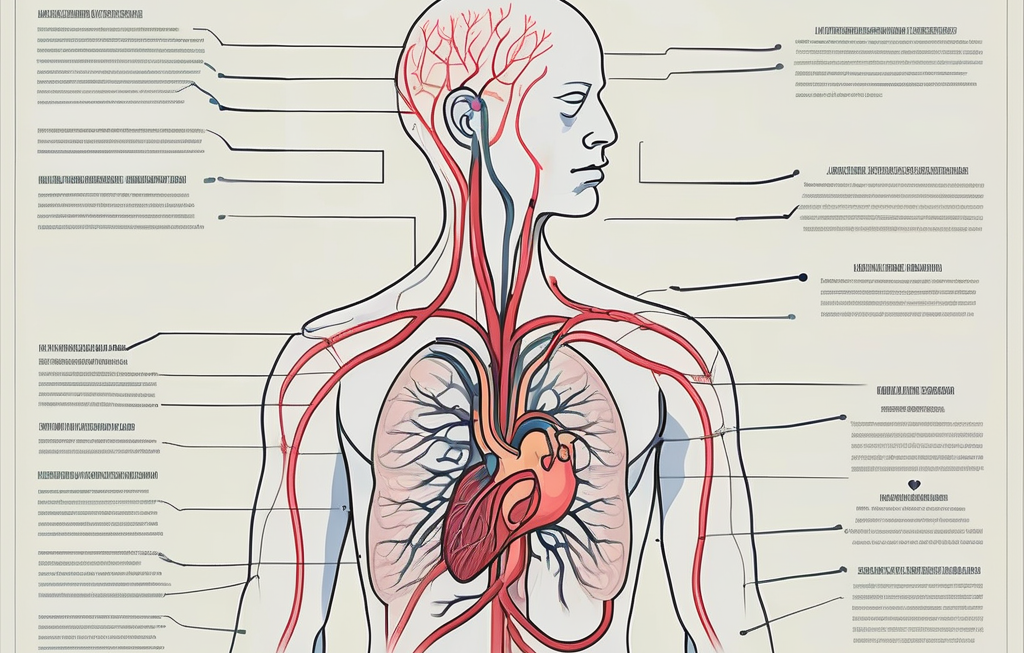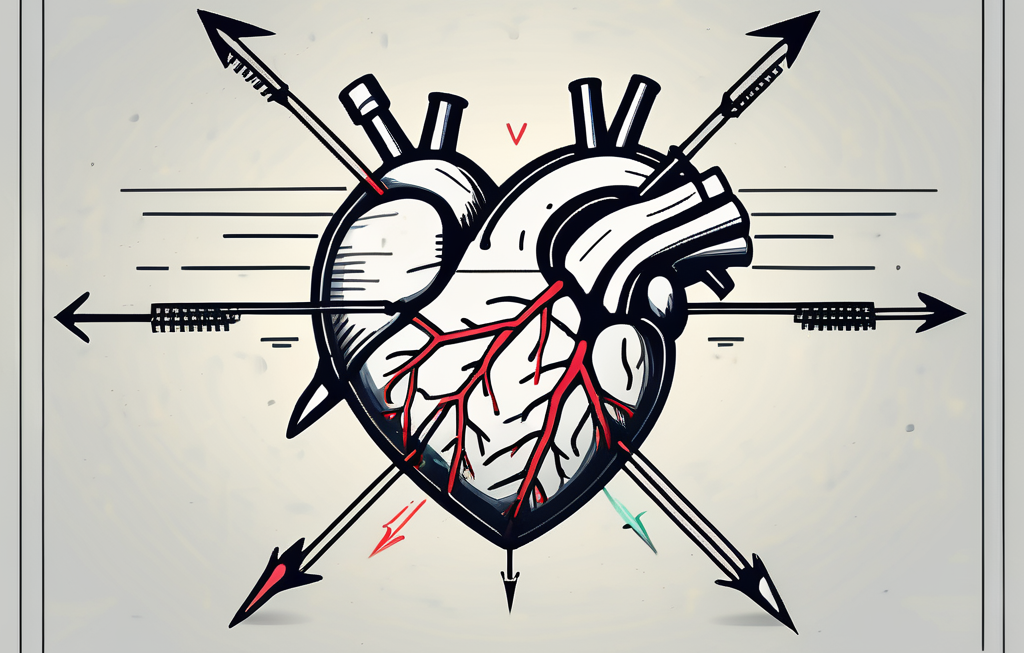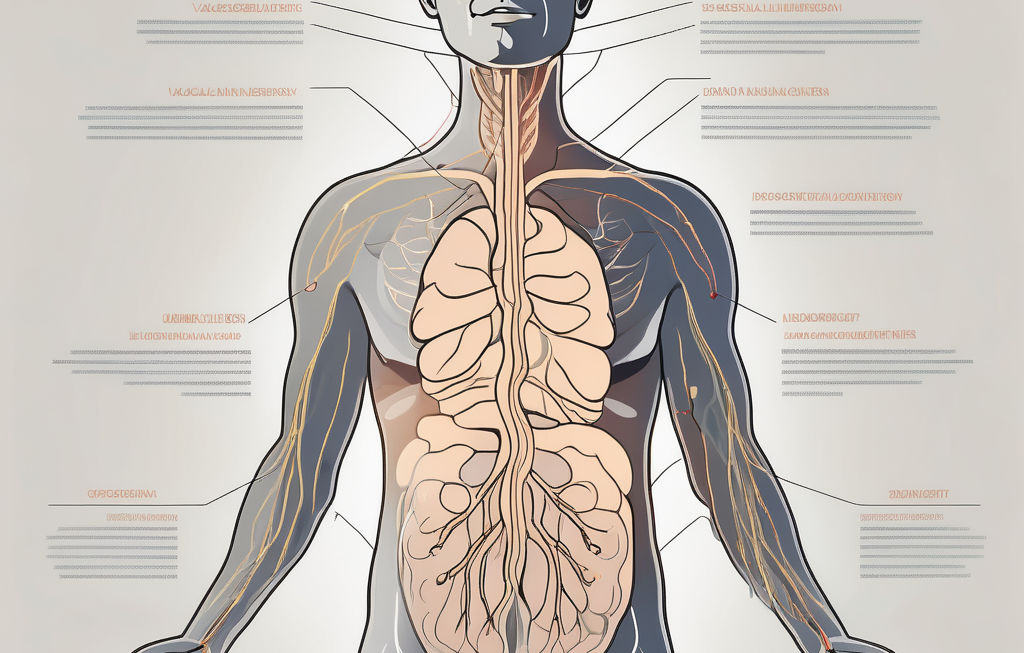The human body is a complex network of interconnected systems, each with its own role in maintaining overall health and well-being. Among these systems, the nervous system plays a crucial role in regulating various bodily functions. One key component of the nervous system is the vagus nerve, which is responsible for controlling the parasympathetic functions of the body.
Understanding Vagal Tone and Its Function
Before delving into the connection between increased vagal tone and bradycardia, it is important to grasp the concept of vagal tone itself. Vagal tone refers to the level of activity of the vagus nerve. It can be thought of as a measure of how sensitive and responsive the body’s parasympathetic nervous system is to external stimuli.
The Role of the Vagus Nerve in the Body
The vagus nerve is one of the longest cranial nerves in the body, extending from the brainstem to various organs including the heart, lungs, and digestive system. It serves as a vital communication pathway between the brain and these organs. The vagus nerve is responsible for regulating numerous bodily functions, including heart rate, digestion, and respiration.
Defining Vagal Tone: An Overview
In simple terms, vagal tone refers to the balance between the sympathetic and parasympathetic nervous systems. The sympathetic nervous system activates the body’s fight-or-flight response, while the parasympathetic nervous system promotes rest and relaxation. Vagal tone, therefore, represents the dominance of the parasympathetic system and its influence on physiological processes.
It is fascinating to note that vagal tone can be influenced by various factors, such as stress levels, physical activity, and even social interactions. For example, engaging in deep breathing exercises or meditation has been shown to increase vagal tone, leading to a state of calm and relaxation. On the other hand, high levels of stress or anxiety can decrease vagal tone, resulting in a heightened state of alertness and tension.
Furthermore, research has indicated that individuals with higher vagal tone may experience benefits such as improved cardiovascular health, better digestion, and enhanced emotional regulation. This highlights the importance of maintaining a healthy balance between the sympathetic and parasympathetic nervous systems to promote overall well-being. By understanding the intricacies of vagal tone and its function, we can explore ways to optimize this physiological mechanism for better health outcomes.
The Connection Between Vagal Tone and Heart Rate
The influence of vagal tone on heart rate is well-established, with studies highlighting its profound impact on cardiovascular health. The parasympathetic signals conveyed by the vagus nerve act as a natural co-regulatory mechanism for the heart, helping maintain a steady heartbeat. However, an increase in vagal tone can have unintended consequences, leading to bradycardia.
Furthermore, recent research has delved into the intricate relationship between vagal tone and heart rate variability (HRV). HRV refers to the variation in time intervals between consecutive heartbeats and is a crucial indicator of overall heart health. High vagal tone is associated with increased HRV, which is linked to better cardiovascular fitness and resilience to stress.
The Vagus Nerve’s Impact on Heart Function
The vagus nerve plays a significant role in heart function by decreasing heart rate. This is accomplished through the release of acetylcholine, which acts on specialized cells in the heart known as sinoatrial (SA) node cells. The SA node is often referred to as the heart’s natural pacemaker, as it generates electrical signals that coordinate and regulate the heartbeat.
Moreover, beyond its effects on heart rate, the vagus nerve also influences other aspects of cardiovascular function, such as blood pressure regulation and the inflammatory response. This highlights the multifaceted role of the vagus nerve in maintaining overall cardiovascular homeostasis.
How Vagal Tone Influences Heart Rate
An increase in vagal tone enhances the influence of the parasympathetic nervous system on the SA node, resulting in a decrease in heart rate. This can be particularly noticeable during times of rest or relaxation. While a lower resting heart rate is generally considered beneficial, excessively high vagal tone can lead to bradycardia, a condition characterized by an abnormally slow heart rate.
It is important to note that vagal tone is not solely determined by genetic factors but can also be influenced by lifestyle choices such as regular physical activity, mindfulness practices, and adequate sleep. By promoting optimal vagal tone, individuals can potentially improve their heart rate variability and overall cardiovascular health in the long term.
The Mechanism of Bradycardia
Understanding the mechanism behind bradycardia can help shed light on how increased vagal tone can cause this condition. Bradycardia is defined as a heart rate of fewer than 60 beats per minute in adults. It can be caused by various factors, including medications, underlying medical conditions, and, in this case, increased vagal tone.
When delving into the intricacies of bradycardia, it is essential to recognize the vital role the sinoatrial (SA) node plays in orchestrating the heart’s rhythm. The SA node, often referred to as the heart’s natural pacemaker, generates electrical impulses that initiate each heartbeat. In the context of bradycardia, disruptions in the SA node’s function can result in a slower heart rate, impacting the body’s overall cardiovascular performance.
What is Bradycardia?
Bradycardia is a condition in which the heart beats at an unusually slow pace, depriving the body of the necessary oxygen and nutrients. While some individuals naturally have a lower resting heart rate, bradycardia can become a concern when symptoms arise, such as dizziness, fatigue, or fainting.
Furthermore, the manifestation of bradycardia can vary depending on the underlying cause. For instance, athletes may exhibit bradycardia as a result of their well-conditioned cardiovascular system, whereas individuals with certain medical conditions or medication side effects may experience it due to pathological reasons. This diversity in etiology underscores the importance of a comprehensive evaluation to pinpoint the specific factors contributing to bradycardia in each individual.
The Physiological Process Behind Bradycardia
In individuals with increased vagal tone, the heightened parasympathetic activity can exert excessive influence on the SA node, leading to a decrease in heart rate. This can occur even at rest or during mild physical activities. It is important to note that bradycardia caused by increased vagal tone is usually not a cause for immediate concern, but rather a reflection of the body’s finely tuned regulatory mechanisms.
Moreover, the intricate interplay between the sympathetic and parasympathetic nervous systems further underscores the complexity of bradycardia’s pathophysiology. While sympathetic activation typically results in an increased heart rate to meet the body’s demands during stress or exertion, vagal dominance can counteract this response, culminating in bradycardia. This delicate balance highlights the dynamic nature of cardiovascular regulation and the multifaceted mechanisms that can contribute to heart rate abnormalities.
The Relationship Between Increased Vagal Tone and Bradycardia
As mentioned earlier, increased vagal tone can be a contributing factor to the development of bradycardia. Let’s explore the intricate relationship between the two in more detail.
Understanding the connection between increased vagal tone and bradycardia is crucial in comprehending the complexities of cardiovascular health. The vagus nerve, a key component of the parasympathetic nervous system, plays a significant role in regulating heart rate. When the vagal tone is elevated, it exerts a powerful influence on the sinoatrial node, the heart’s natural pacemaker, causing it to fire at a slower rate.
The Effect of High Vagal Tone on Heart Rate
In individuals with increased vagal tone, the parasympathetic fibers of the vagus nerve transmit more signals to the heart, ultimately leading to a slower heart rate. While this can be beneficial in certain situations, such as during sleep or relaxation, prolonged periods of bradycardia may pose potential health risks.
Moreover, the relationship between vagal tone and bradycardia extends beyond heart rate regulation. Studies have shown that heightened vagal activity can also influence other cardiac functions, such as atrioventricular conduction and myocardial contractility. These intricate mechanisms highlight the multifaceted impact of vagal tone on the cardiovascular system.
Why Increased Vagal Tone Leads to Bradycardia
While increased vagal tone is a physiological response that helps maintain homeostasis, excessively high vagal tone can result in bradycardia. Various factors can contribute to this, such as genetics, certain medications, and underlying medical conditions. It is important to consult with a healthcare professional to determine the cause of bradycardia and develop an appropriate management plan.
Furthermore, the interplay between vagal tone and bradycardia underscores the importance of individualized treatment approaches. By addressing the underlying factors contributing to increased vagal tone, healthcare providers can tailor interventions to optimize heart rate regulation and overall cardiovascular function. This personalized approach is essential in mitigating the potential risks associated with prolonged bradycardia and ensuring the maintenance of a healthy heart rhythm.
Potential Health Implications of High Vagal Tone and Bradycardia
Understanding the potential health implications of increased vagal tone and bradycardia is crucial for managing one’s well-being and seeking appropriate medical guidance.
It is important to recognize that vagal tone plays a significant role in regulating various bodily functions, including heart rate, digestion, and stress responses. High vagal tone is often associated with a state of relaxation and can contribute to overall cardiovascular health. However, when vagal tone becomes excessively high, it may lead to bradycardia, a condition characterized by an abnormally slow heart rate.
Risks and Symptoms Associated with Bradycardia
While bradycardia itself may not pose an immediate threat to health, it can be associated with symptoms that warrant medical attention. These symptoms may include lightheadedness, fainting, fatigue, and difficulty concentrating. In some cases, bradycardia may result in reduced cardiac output, potentially leading to complications.
It is crucial for individuals experiencing symptoms of bradycardia to undergo thorough medical evaluation to determine the underlying cause and appropriate treatment. In some instances, bradycardia may be a result of an underlying medical condition, such as hypothyroidism or heart disease, requiring targeted interventions to manage effectively.
The Long-Term Impact of Increased Vagal Tone on Heart Health
While increased vagal tone and bradycardia may be interconnected, it is important to note that not all individuals with high vagal tone will develop these conditions. However, individuals with prolonged bradycardia or underlying heart conditions may be at a higher risk for adverse cardiac events. Regular monitoring and appropriate medical intervention are essential for maintaining heart health.
Furthermore, strategies aimed at modulating vagal tone, such as mindfulness practices, deep breathing exercises, and physical activity, can help promote a healthy balance in autonomic nervous system activity. By incorporating these lifestyle modifications, individuals may mitigate the potential risks associated with excessive vagal tone and bradycardia, ultimately supporting their overall well-being.
Managing and Treating Bradycardia Caused by High Vagal Tone
Addressing bradycardia caused by increased vagal tone requires a comprehensive approach that focuses on managing the underlying factors contributing to the condition.
Bradycardia, characterized by an abnormally slow heart rate, can be a result of high vagal tone. The vagus nerve, a key player in the autonomic nervous system, plays a crucial role in regulating heart rate. When the vagus nerve becomes overactive, it can lead to excessive parasympathetic influence on the heart, causing bradycardia.
Medical Interventions for Bradycardia
In severe cases, medical interventions may be necessary to address bradycardia caused by high vagal tone. These interventions may include the use of medications, such as beta-blockers or anticholinergic drugs, to counteract the excessive parasympathetic influence on the heart. Beta-blockers work by blocking the effects of adrenaline, which can help regulate heart rate. Anticholinergic drugs, on the other hand, inhibit the action of the vagus nerve, reducing its influence on the heart. In certain situations, a pacemaker may be implanted to help regulate heart rate by sending electrical impulses to the heart when necessary.
It is important to note that medical interventions should always be prescribed and monitored by a healthcare professional. They will assess the severity of the bradycardia and determine the most appropriate course of action.
Lifestyle Changes to Improve Vagal Tone and Heart Health
In addition to medical interventions, lifestyle modifications can play a significant role in managing high vagal tone and bradycardia. Incorporating regular exercise into one’s routine can help improve overall heart health and vagal tone. Engaging in activities such as aerobic exercises, like jogging or swimming, can stimulate the sympathetic nervous system, which can counterbalance the excessive parasympathetic influence on the heart.
Furthermore, stress management techniques, such as deep breathing exercises, meditation, or yoga, can help reduce stress levels and promote a healthier vagal tone. Chronic stress can contribute to an overactive vagus nerve, so finding effective ways to manage stress can be beneficial in managing bradycardia.
A balanced diet is also essential in promoting heart health and improving vagal tone. Consuming foods rich in omega-3 fatty acids, such as fatty fish like salmon or mackerel, can help reduce inflammation and support cardiovascular health. Additionally, incorporating fruits, vegetables, whole grains, and lean proteins into one’s diet can provide essential nutrients that support overall heart health.
However, it is important to consult with a healthcare professional before making any significant changes to one’s lifestyle. They can provide personalized guidance and ensure that any modifications align with individual health needs and goals.
By adopting a comprehensive approach that combines medical interventions and lifestyle modifications, individuals can effectively manage bradycardia caused by high vagal tone. It is crucial to seek appropriate medical guidance to ensure a well-balanced and informed approach to overall well-being.



